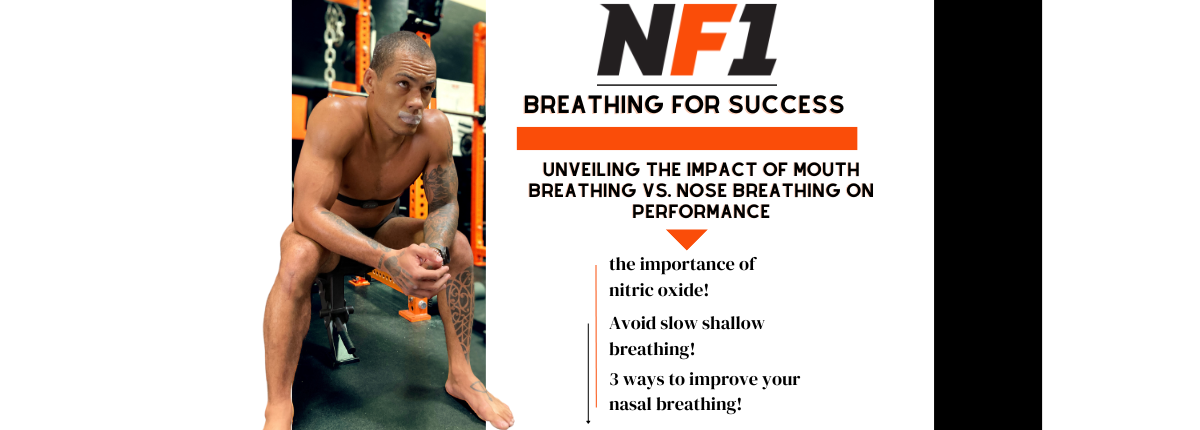
Nose vs mouth breathing for performance?
Breathing is an essential process that delivers oxygen to our body and removes carbon dioxide. It is crucial for athletes to understand the differences between nose and mouth breathing to improve their athletic performance.
Nasal Breathing:
Breathing through the nose has several advantages over breathing through the mouth. The nose warms, humidifies, and filters the air we breathe, which helps to protect the lungs from irritants, pollutants, and allergens. In addition, the nasal passages produce nitric oxide, which helps to increase blood flow and oxygen delivery to the muscles.
Nose breathing is also more efficient than mouth breathing because it allows for slower, deeper breaths. The diaphragm, which is the primary muscle responsible for breathing, is better engaged during nasal breathing, which can lead to improved oxygen uptake and better endurance performance.
Furthermore, breathing through the nose can help to activate the parasympathetic nervous system, which is responsible for relaxation and digestion. This can help to reduce stress levels and improve mental clarity during training or competition.
Mouth Breathing:
Mouth breathing, on the other hand, can have several disadvantages for athletes. Breathing through the mouth bypasses the nasal passages, which means that the air is not warmed, humidified, or filtered. This can lead to irritation of the airways, which can cause coughing, throat irritation, and increased susceptibility to respiratory infections.
Mouth breathing is also less efficient than nasal breathing because it allows for shallower, faster breaths. This can lead to increased respiratory rate and reduced oxygen uptake, which can negatively impact endurance performance.
In addition, mouth breathing can increase the risk of dehydration because it allows for more significant water loss through exhaled air. This can be particularly problematic for athletes who engage in prolonged, high-intensity exercise.
Which is better for performance?
Overall, nose breathing is generally considered to be better for performance than mouth breathing. Nose breathing allows for better oxygen uptake, improved endurance, and reduced stress levels. It also provides additional benefits, such as warming, humidifying, and filtering the air we breathe.
However, there are situations where mouth breathing may be necessary, such as during high-intensity exercise or when the nasal passages are blocked due to allergies or illness. In these situations, athletes may need to breathe through their mouths to maintain adequate oxygen uptake and prevent respiratory distress.
Overall, breathing is a crucial aspect of athletic performance, and athletes should be aware of the differences between nose and mouth breathing. Nasal breathing can provide several benefits, such as improved oxygen uptake, endurance, and stress reduction, while mouth breathing can have several disadvantages, such as increased respiratory rate, reduced oxygen uptake, and increased risk of dehydration. Athletes should aim to breathe through their nose whenever possible but may need to switch to mouth breathing during high-intensity exercise or when experiencing nasal congestion.
3 tips to practice nasal breathing as an athlete
- Breath of Fire: inhale passively and exhale forcefully. The exhale, which requires you to contract your abdominal muscles, is the main focus of this technique. Also, the inhale and exhale should be the same length, without any pauses in between. This is different from slow breathing exercises, which often involve longer exhales. With this technique, the pattern of your breathing is more important than the speed. So, start slow if you’re new to the technique. You can speed it up later on. Breath of Fire is done in a seated position. It can last anywhere from 30 seconds to 10 minutes, depending on your experience level and preference.
- Interval Training with Nasal Breathing: Interval training involves alternating between high-intensity bursts of exercise and lower-intensity recovery periods. During your lower-intensity phases, consciously switch to nasal breathing. This practice not only helps you recover more efficiently but also conditions your body to perform better while breathing through the nose. Over time, you’ll find it easier to maintain nasal breathing even during intense workout segments.
- Breathing Technique Awareness During Workouts: Pay attention to your breathing technique while performing various exercises. Focus on keeping your mouth closed and breathing exclusively through your nose whenever possible. This might require adjusting the intensity of your workouts initially. Listen to your body and gradually build up your capacity for nasal breathing during more demanding exercises. Consistently practicing nasal breathing during workouts can improve oxygen utilization, increase aerobic endurance, and enhance overall performance.
Find a program that is just right for you in our NF1 App! Download today and start your free 14 day trial!
